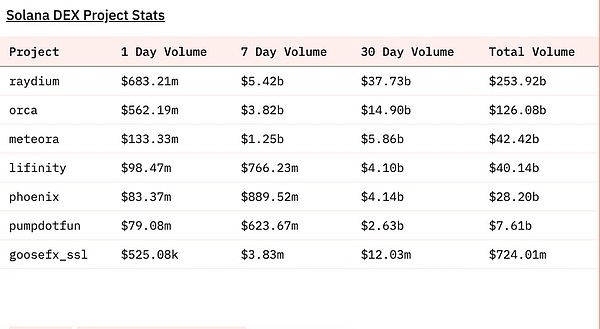Written by Yangz, Techub News
Recently, major KOLs on CT discussed the question raised by Hasu, "Why is trading on Solana still dominated by AMM (automated market maker) rather than CLOB (centralized limit order book)?" People wondered that based on the efficient performance chain that can process thousands of transactions per second, DEX on Solana can completely adopt the order book model to provide low slippage transactions, but current data shows that the market's choice is DEX using the AMM mechanism.
According to the Dune dashboard data created by @ilemi, as of the time of writing, the total transaction volume of DEX on Solana is about 499.08 billion US dollars. In terms of market share, Raydium and Orca, which adopt the AMM model, account for most of the transactions with a ratio of 41.5% and 34.5% respectively, while Phoenix and Lifinity, which adopt the CLOB model, account for only 5.1% and 6%. In addition, judging from the transaction volume data, the transaction volume of the former two is also several times that of the latter two.


Regarding this phenomenon, Multicoin Managing Partner Kyle Samani commented under Hasu's tweet that "long-tail assets lack order book market makers." Considering the popularity of memecoin in the Solana ecosystem, Samani's implication is that most of the trading volume of DEXs that adopt the AMM mechanism on Solana comes from memecoin. However, Doug Colkitt, founder of decentralized trading platform Ambient Finance, countered this explanation that attributes the cause to memecoin, saying, "Most people think that 'all Solana AMM trading volume comes from long-tail assets,' but these analyses are wrong. Just use your brain and spend 30 seconds to verify it." Colkitt explained that in the past 24 hours, Orca (AMM) alone had a trading volume of $250 million in its two largest SOL/USDC trading pairs. In comparison, the two largest SOL/USD pairs on Phoenix (CLOB) have a trading volume of about $14 million. In addition, he joked that "maybe many CLOB market makers are not working on weekends", so he looked at the 7d average daily trading volume of the above trading pairs on Phoenix, and the result was only $168 million.
Colkitt also pointed out that any trader who has used Jupiter for SOL and USDC trading knows that although Phoenix and Lifinity perform well, in most cases, normal-sized transactions are conducted through Orca or Raydium. (Note: Kyle Samani admitted his mistake after seeing Colkitt’s analysis above, saying that he “does not trade SOL-USD, only stakes and holds.”)
Colkitt concluded that even on a high-performance network like Solana, AMMs are still very competitive and largely the default on-chain trading method for pairs like SOL/USD that have high liquidity, high trading volume, and are attractive to HFT market makers.
So, since memecoin is not the trigger for this phenomenon, what is the real reason behind it?
Most KOLs attribute the reason to the advantages of AMMs over CLOBs. Guillaume Lambert, founder of Panoptic, a DeFi protocol based on Uniswap, said, "AMM is first and foremost a product for teams/LPs/token issuers. No one wants to manage an order book, and LPing is much easier." Similar to Lambert, former Spartan Capital general partner Jason Choi also pointed out that this is because "teams/memes can more easily issue tokens through AMM pools."
In addition, @sidmvenkat of Electric Capital analyzed the attributes of assets in the current Solana ecosystem. He said, "For larger and more mature assets, traders can benefit from the CLOB model. Once the asset is large enough, "experienced" participants have reason to start making markets for it; and most of the assets on Solana are newer assets, so it is easier to establish liquidity using the AMM mechanism." Peter Kris of the cross-chain trading protocol Gasp even rose to the perspective of industry value. He believes that the problem with CLOB is that it is inconsistent with Crypto value. "The liquidity provision on CLOB is concentrated in the hands of a few experienced players, while AMM allows everyone to be a market maker. The rewards are distributed fairly, and capital (liquidity) is not in the hands of a few people." In addition, a more interesting point is the "background" of the development of Solana ecosystem DEX raised by X user @youyouAllen. He pointed out that "Solana's order book was mainly influenced by the will of the explosive head, and now SBF has entered, the market has returned to the real user needs. The market finally chose AMM." Indeed, as ordinary investors, we may not need to delve into this phenomenon. The so-called "standard answer" is nothing more than the choice of the market. The simplest conclusion is that, as far as the current situation is concerned, AMM may be more suitable for Solana ecosystem DEX than CLOB. From a higher level, discussions like the AMM vs. CLOB debate will be of great benefit to the current bleak DeFi ecosystem. Paradigm research partner Frankie commented, "Couple more AMM vs CLOB debates then up only".

 JinseFinance
JinseFinance
 JinseFinance
JinseFinance JinseFinance
JinseFinance JinseFinance
JinseFinance JinseFinance
JinseFinance JinseFinance
JinseFinance JinseFinance
JinseFinance Clement
Clement Bitcoinist
Bitcoinist Bitcoinist
Bitcoinist Cointelegraph
Cointelegraph